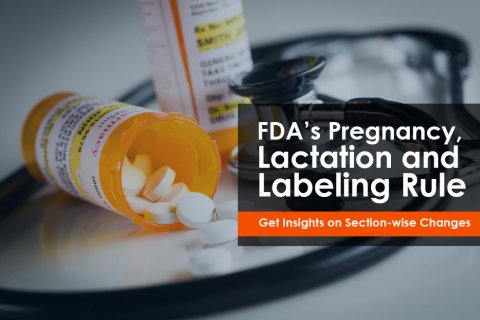The United States Food and Drug Administration’s (USFDA’s) Pregnancy, Lactation and Labeling Rule (PLLR), which came into effect in June 2015, establishes a labeling standard for prescription drug products which can be used during maternity and lactation. In addition, to overcome the current prescription drug labeling information, the new rule focuses more on content and format changes under Physician Labeling Rule (PLR), too.
Drug consumption during pregnancy and lactation is often left to the discretion of medical practitioners. According to a report, on an average, a pregnant woman takes 2.6 prescription medications at any time during pregnancy. Un-informed or misdirected drug use during this time can lead to health complications, which the USFDA attempts to prevent with necessary instructions through this guidance.
Prescription drug labeling assists healthcare professionals in prescribing appropriate medicine. This, in turn, helps them communicate better with the patients which also leads to increased vigilance. With PLLR, FDA aims to achieve uniform communication of risks and benefits of drug products which can be used during pregnancy and lactation.
PLLR is applicable to a spectrum of applications including New Drug Applications (NDAs), Biologics License Applications (BLAs) and efficacy supplements to BLAs. FDA’s updated PLLR guidance indicates the allocation of new subsections under:
- 8.1 Pregnancy
- 8.2 Lactation and,
- 8.3 Females and Males of Reproductive Potential of USE IN SPECIFIC POPULATIONS section of the full prescribing information (FPI)
8.1 Pregnancy
Previously, this subsection dealt with Labor and delivery information. But the contents of the final draft were altered and it was assigned for ‘Pregnancy’ with additional information on Labor and delivery in the same subsection of Labeling.
Additionally, in coherence with comments from patients and professionals, the final rule also eliminates the long-standing pregnancy categories (A, B, C, D & X) which were deemed inconsistent while communicating degrees of fetal risk. Alternatively, the final guidance requires a narrative summary stating drug risk during pregnancy.
The final FDA rule of Pregnancy and Lactation labeling recommends subheadings and extensive information relevant to them be presented in the subsections as:
- Pregnancy Exposure Registry - The registry monitors pregnancy outcomes in women using the drug during pregnancy. It can be omitted if it is not applicable to the drug.
- Risk Summary - This subheading is not optional. It must provide risk statements and developmental outcomes of drug based on different types of data acquired during the clinical tests of the drug such as:
- Risk Statement based on human data
- Risk Statement based on animal data
- Risk Statement based on pharmacology
- Clinical Considerations – This subsection must offer information to further inform prescribing and risk-benefit counselling. There are 5 headings under this subheading. If the heading is not applicable, the final rule recommends omission.
- Disease-associated maternal and/or embryo/fetal risk
- Dose adjustments during pregnancy and the postpartum period
- Maternal adverse reactions
- Fetal/Neonatal adverse reactions
- Labor or delivery
- Data – This subheading is required to put scientific data based on which Risk Summary and Clinical Considerations have been put forth. The data must be relevantly presented in the following categories as applicable.
- Human Data
- Animal Data
8.2 Lactation
This subsection was put in place replacing the earlier subsection ‘Nursing mothers’. To provide clarity, the final rule recommends additional subheading in the subsection.
- Risk Summary – A summary of risk must be provided irrespective of applicability. If the drug is not systematically absorbed by the person consuming it, the same must be stated in the format specified in the PLLR. And, if it is absorbed, the results must be reported under these headings as applicable.
- Presence of drug in human milk
- Effects of drug on the breastfed child
- Effects of drug on milk production/excretion
- Risks and benefit statement
- Clinical Considerations – This subsection of 8.2 must describe headings following below with information to the extent available. They must be omitted if the applicant finds no relevant information.
- Minimizing exposure
- Monitoring for adverse reactions
- Data – Similar to the 8.1 section, data on Risk Summary and Clinical Considerations must be made available under this subheading. It may be omitted if no data is available on them.
8.3 Females and Males of Reproductive Potential
This is a newly created/added subsection. It must provide information on pregnancy testing, contraception, and infertility, all of which were earlier distributed over different sections (Pregnancy subsection, and ‘Warnings and Precautions’ section of Labeling). PLLR establishes that this subsection needs information in case there are any recommendations/requirements for pregnancy test and/or contraception before, during, or after drug therapy and/or there are human and/or animal data suggesting an effect on fertility and/or preimplantation loss effects due to the drug. The relevant information, if found, must be provided under the categories provided below as applicable.
- Pregnancy Testing
- Contraception
- Infertility
Further, the US FDA has recommended general principles that must be ensured in relation to the implementation of PLLR. The understanding of these principles individually will reveal as follows:
- Revising Labeling: It is a common understanding that content of Labeling be updated whenever existing Labeling information is changed. The applicants should note that the revised Labeling, complying with the PLLR regulations, should also evaluate that the current version reflects the latest requirements.
- Formatting: The PLLR requires for bolded Subsection numbers and titles in the FPI. In addition, the rule also recommends subheadings within the subsections be italicized and/or underlined. The heading titles must be either italicized or underlined. After choosing any approach from these recommendations, there must be a consistency of implementation throughout the Labeling.
- Cross-Referencing: Cross-Referencing for PLLR follows the general principle recommended for PLR. To make the Labeling detail and relevant for patient, non-inclusive topics may briefly be needed to explain. In such cases, a brief discussion about the topic must be provided following it with a cross-reference to the section for a detailed discussion.
Timelines for implementation
The PLLR is perceived as a comprehensive final guide for Labeling by the FDA. It became effective on June 30, 2015. The agency has allocated generous timelines (three to five years) for implementation. For all Biological product or drug applications,
- Approved between June 30, 2007 – June 30, 2015, the PLLR must be implemented within 4 years from effective date.
- Pending approval on June 30, 2015, the PLLR must be implemented within 4 years of effective date or approval date, whichever is later.
- Submitted on or after June 30, 2015, the PLLR must be implemented by the submission.
- Further, all older medications and over-the-counter products approved before June 30, 2001, must neither have a letter based pregnancy category or a narrative summary
The prescription of drugs and Biologics for lactating and pregnant women is highly individualized. So, a case-wise prescription will require an extensive report from the clinical trial end of the applicant. The new face of PLLR is set to address all these requirements for making it an effective rule for implementation.
But the rule requires precise extraction of information for existing products and a continuous tracking of data for aspiring applicants. There are more criteria that are to be decoded with reference to individual subheadings and headings, while Labeling basing on the rule. Applicants are also required to warrant an acceptable language in content and format. With the rule already in the implementation phase, a competent labeling expert is required to curate the application and ensure quality before submission. Be informed. Be compliant.





